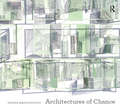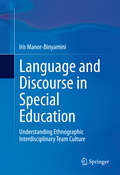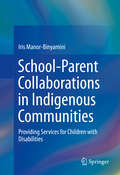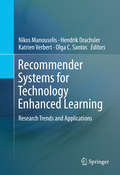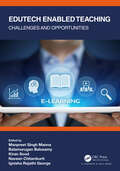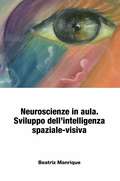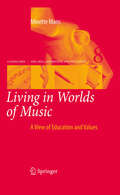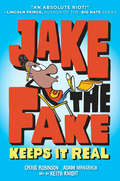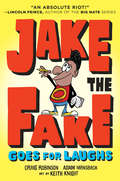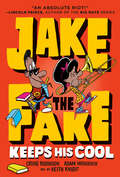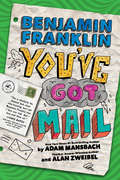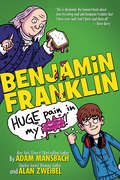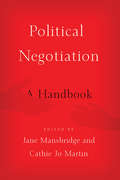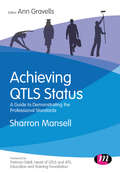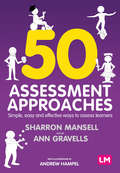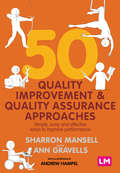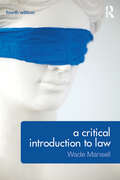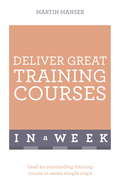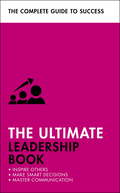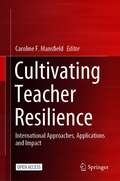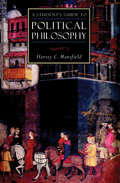- Table View
- List View
Architectures of Chance (Design Research in Architecture)
by Yeoryia ManolopoulouArchitectural discourse and practice are dominated by a false dichotomy between design and chance, and governed by the belief that the architect’s role is to defend against the indeterminate. In Architectures of Chance Yeoryia Manolopoulou challenges this position, arguing for the need to develop a more creative understanding of chance as aesthetic experience and critical method, and as a design practice in its own right. Examining the role of experimental chance across film, psychoanalysis, philosophy, fine art and performance, this is the first book to comprehensively discuss the idea of chance in architecture and bring a rich array of innovative practices of chance to the attention of architects. Wide-ranging and through a symbiotic interplay of drawing and text, Architectures of Chance makes illuminating reading for those interested in the process and experience of design, and the poetics and ethics of chance and space in the overlapping fields of architecture and the aleatoric arts.
Language and Discourse in Special Education
by Iris Manor-BinyaminiThis book examines the words and discourse as well as their meaning and impact on the everyday culture of a multidisciplinary team at a school for students with mental disabilities. The book examines the organizational, social, professional, and emotional experiences of team members from such disciplines as child and school psychology, special education, therapy (e. g. , occupational, speech), social work, and pediatric medicine within a special education school. It explores the ways in which team members describe and interpret the day-to-day requirements of working effectively in a special education school, using their own language and discourse from a subjective point of view. In addition, the book analyzes and interprets the influence of language and discourse on the outlook, behavior patterns, and the coping of team members working in the school with the students, among themselves as a team, and with the difficulties and dilemmas that concern them as well the solutions that they themselves introduce for all these issues. This book, with its focus on the unique and complex work environment of the multidisciplinary special education team, is essential reading for researchers, professionals, and graduate students in child and school psychology, therapeutic disciplines (e. g. , occupational, speech), social work, pediatric medicine, and allied mental health and medical fields.
School-Parent Collaborations in Indigenous Communities
by Iris Manor-BinyaminiPoverty. Lack of social support. Limited access to education. High risk for health problems. Indigenous communities face an inordinate number of hardships. But when children have special needs, these problems multiply exponentially, making existing difficulties considerably worse. School-Parent Collaborations in Indigenous Communities: Providing Services for Children with Disabilities begins with an in-depth overview of indigenous experience and psychology, and situates disabilities within the contexts of indigenous communities and education services. The pilot study at the core of the book, conducted among the Bedouins of southern Israel, shows this knowledge in action as special education personnel engage parents in interventions for their children. Going beyond facile concepts of cultural sensitivity, the model recasts professionals as cultural mediators between school and family. This practice-oriented information has the potential to improve not only the well-being of children and families, but of the greater community as well. Featured in the coverage: Unique characteristics of indigenous communities and children with disabilities. Psychological models of reactions to disability. Benefits of multidisciplinary teams. Factors affecting collaboration between indigenous parents of children with disabilities and school professionals. Core principles of indigenously attuned collaboration. An extended case study on collaboration between parents of children with disabilities and school professionals in a Bedouin community. School-Parent Collaborations in Indigenous Communities is a breakthrough resource for researchers, graduate students, and professionals working with special needs children in child and school psychology, international and comparative education, social work, cross-cultural psychology, public health, and educational psychology.
Three Native Nations Of the Woodlands, Plains, and Desert
by John K. Manos Ron Himler Ted HammondNIMAC-sourced textbook
Recommender Systems for Technology Enhanced Learning
by Nikos Manouselis Hendrik Drachsler Katrien Verbert Olga C. SantosAs an area, Technology Enhanced Learning (TEL) aims to design, develop and test socio-technical innovations that will support and enhance learning practices of individuals and organizations. Information retrieval is a pivotal activity in TEL and the deployment of recommender systems has attracted increased interest during the past years. Recommendation methods, techniques and systems open an interesting new approach to facilitate and support learning and teaching. The goal is to develop, deploy and evaluate systems that provide learners and teachers with meaningful guidance in order to help identify suitable learning resources from a potentially overwhelming variety of choices. Contributions address the following topics: i) user and item data that can be used to support learning recommendation systems and scenarios, ii) innovative methods and techniques for recommendation purposes in educational settings and iii) examples of educational platforms and tools where recommendations are incorporated.
Edutech Enabled Teaching: Challenges and Opportunities
by Manpreet Singh Manna Balamurugan Balusamy Kiran Sood Naveen Chilamkurti Ignisha Rajathi GeorgeThe primary goal of this book is to address the issues faced by teachers in the adoption of digital tools into their teaching and their students learning. This book also addresses the issues confronting educators in the integration of digital technologies into their teaching and their students’ learning. Such issues include a skepticism of the added value of technology to educational learning outcomes, the perception of the requirement to keep up with the fast pace of technological innovation, a lack of knowledge of affordable educational digital tools and a lack of understanding of pedagogical strategies to embrace digital technologies in their teaching. This book presents theoretical perspectives of learning and teaching today’s digital students with technology and proposes a pragmatic and sustainable framework for teachers’ professional learning to embed digital technologies into their repertoire of teaching strategies in a systematic, coherent and comfortable manner so that technology integration becomes an almost effortless pedagogy in their day-to-day teaching. Some of the objectives are given below: Shares valuable insights into the influence of technology on teaching and learning in higher education Provide deeper insights on higher education and sustainability interact Studies innovations from various perspectives Investigate how the educators and students apply the unique innovative and emotional dimensions in modern age of learning Provides a timely overview of changes in education reforms and policy research globally Evaluates the problematic relationship between globalization, the state, and education reforms.
Neuroscienze in aula. Sviluppo dell’intelligenza spaziale-visiva.
by Beatriz Manrique Giuseppina De VitaL’obiettivo centrale del testo è quello di facilitare l’accesso al discorso sulla neuroscienza e come utilizzarla in aula, principalmente attraverso lo sviluppo dell’intelligenza spaziale-visiva proposta tanto da Gardner come da Beauport, due teorici delle intelligenze multiple. Si sviluppa l’uso della visualizzazione, l’abilità per arrivare all’astrazione degli spazi, come opzione di attività in classe progettate nell’ottica di un’educazione integrale. I temi presentati sono organizzati in nove parti: l’introduzione, un’intervista a una famosa maestra, la bilateralità cerebrale, un modello di analisi che parte dall’insegnamento delle lingue, il lavoro con le immagini, l’intelligenza visiva e la creatività, le immagini in aula, una proposta di attività con immagini e le conclusioni. In ciascuna parte si sviluppano differenti aspetti relazionati all’applicazione delle neuroscienze in una classe di lingue straniere, ma solo come esempio di applicazione poiché che l’obiettivo dell’autrice è di presentare, in maniera chiara, l’applicabilità della neuroscienza a tutte le aree di insegnamento e con molti esempi che facilitino l’estrapolazione dell’informazione ad altri campi. L’intervista con una maestra venezuelana di larghe vedute - Alicia Steiner – è uno dei migliori esempi, poiché mostra di fatto che quando si vuole, ci si prepara e si agisce, si raggiungono gli obiettivi. Le pratiche che vengono suggerite e gli esercizi che vengono descritti sono stati utilizzati in aula dalla stessa autrice, che offre la possibilità di espandere il loro utilizzo ad altre aree. Infine, nel testo sono raccolte varie attività visive come esempi di possibile utilizzo nel primo giorno di lezione. Le conclusioni includono, inoltre, riflessioni su tutto il processo del lavoro del docente secondo questo metodo.
Living in Worlds of Music
by Minette MansInformed by her in-depth ethnomusical knowledge, the result of detailed fieldwork, Mans's book is about musical worlds and how we as people inhabit them. The book asserts that an understanding of our musical worlds can be a transformative educational tool that could have a significant role to play in multicultural music and arts education. She explores the way in which musical expression, with its myriad cultural variations, reveals much about identity and cultural norms, and shows how particular musical sounds are aesthetically related to these norms. The author goes further to suggest that similar systems can be detected across cultures, while each world remains colored by a distinctive soundscape. Mans also looks at the way each cultural soundscape is a symbolic manifestation of a society's collective cognition, sorting musical behavior and sounds into clusters and patterns that fulfill each society's requirements. She probes the fact that in today's globalized and mobile world, as people move from one society to another, cross-cultural acts and hybrids result in a number of new aesthetics. Finally, in addition to three personal narratives by musicians from different continents, the author has invited scholars from diverse specializations and locations to comment on different sections of the book, opening up a critical dialogue with voices from different parts of the globe. Musical categorization, identity, values, aesthetic evaluation, creativity, curriculum, assessment and teacher education are some of the issues tackled in this manner.
Jake the Fake Keeps it Real (Jake the Fake #1)
by Adam Mansbach Keith Knight Craig RobinsonFor fans of Diary of a Wimpy Kid and Big Nate comes a new side-splitting series from comedian and film star Craig Robinson, #1 New York Times bestselling author Adam Mansbach, and NAACP History Maker recipient and cartoonist Keith Knight. Jake can barely play an instrument, not even a kazoo. And his art? It’s better suited for Pictionary than Picasso. Which is a real problem because Jake just faked his way into the Music and Art Academy for the gifted and talented (and Jake is pretty sure he is neither). More jokester than composer, Jake will have to think of something quick before the last laugh is on him. Featuring more than 160 illustrations, Jake the Fake is sure to bring the laughs with his hilarious high jinks!
Jake the Fake Goes for Laughs (Jake the Fake #2)
by Adam Mansbach Craig RobinsonFor fans of Diary of a Wimpy Kid and Big Nate comes the second book in the side-splitting series about a class clown faking his way to comedy stardom from comedian and film star Craig Robinson, #1 New York Times bestselling author Adam Mansbach, and NAACP History Maker recipient and cartoonist Keith Knight."An absolute riot!" --LINCOLN PEIRCE, author of the BIG NATE seriesJake cracks up the crowd as a budding comedian at the Music and Art Academy talent show, but his new ego is no laughing matter. And when he starts blowing off his friends to pursue his "art," Jake's big head becomes a huge bummer.Plus, being the funny man is way tougher than it looks. Luckily, Jake has his mentor Maury Kovalski, a retired comedy showstopper, to teach him the ropes about humor--and humility--before Jake loses all his biggest fans and best friends!Featuring more than 200 illustrations, Jake the Fake stuns again with even greater gags and giggles than before!
Jake the Fake Keeps His Cool (Jake the Fake #3)
by Adam Mansbach Craig RobinsonFor fans of Diary of a Wimpy Kid and Big Nate comes the third book in this laugh-out-loud series about a class clown faking his way through middle school from comedian and film star Craig Robinson, #1 New York Times bestselling author Adam Mansbach, and NAACP History Maker recipient and cartoonist Keith Knight. <p><p> Life couldn't be better for Jake. He's a student at Music and Arts Academy and a budding comedian, and he finally put an end to his fake-ster ways . . . or so he thought. There's a new girl at school, and Jake would do anything to impress her, even pretending to be a master chef. And a world-renowned barber? <p><p> But at home, Jake is less impressed with his mom's news: she's pregnant. Now Jake has to fake being happy about becoming the Middle Child. The King of Cool is about to drop his chill. <p><p> Luckily, he has good friends and laughs on his side, along with more than two hundred illustrations--all about him!
Benjamin Franklin: You've Got Mail (Benjamin Franklin #2)
by Adam Mansbach Alan ZweibelIf the Future has any remedy for this situation, do not hesitate to provide it. That is to say, Ike and Claire Wanzandae, HELP! HELP HELP HELP.I am (perhaps not for long), Benjamin FranklinIke Saturday has seen better days. For one thing, his pen pal, Benjamin Franklin (yes, that Benjamin Franklin), is the target of an angry mob after Ike's plan to help the Founding Fathers with some intel from the future seriously backfired. For another, he's decided to mail himself back in time with the help of his girlfriend, Claire Wanzandae, and it's not a particularly comfortable way to travel.Once Ike tracks B-Freezy down in 1776, it becomes clear that his pal is less than impressed with the irritating, modern-day rescuer, partially because Ike has a habit of making things worse for Ben, and partially because Ben is incredibly cranky when not in the presence of numerous meat pies. Which speaks to another issue for the pair: they have no money, no food, and basically no plan for saving the country. But Claire won't be able to cover for Ike back home in the future forever, and the British are looking pretty impatient, so Ike and B-Freezy will have to come up with something quickly if they want to avoid an epic, history-destroying disaster.In this hilarious sequel to Benjamin Franklin: Huge Pain in My . . . , Adam Mansbach and Alan Zweibel take Ike and B-Freezy's antics to the next level as this ill-paired (and sometimes actually ill) duo hold the future of the world in their not-so-capable hands.
Benjamin Franklin: Huge Pain in my... (Benjamin Franklin #1)
by Adam Mansbach Alan ZweibelDear Mr. Franklin, First of all, let me just say that this Assignment is Stupid. You are Dead. Why am I writing a letter to Some dead guy I've never even met? This is the start to a most unlikely pen pal relationship between thirteen-year-old Franklin Isaac Saturday (Ike) and Benjamin Franklin. Before the fateful extra credit assignment that started it all, Ike's life was pretty normal. He was avoiding the popularity contests of middle school, crushing hard on Clare Wanzandae and trying not roll his eyes at his stepfather, Dirk-the-Jerk's lame jokes. But all that changes when, in a successful effort to make Claire Wanzandae laugh, Ike mails his homework assignment to Ben Franklin???and he writes back. Soon, things go awry. After Ike has an embarrassing moment of epic proportions in front of Claire involving a playground, non-alcoholic beer, and a lot of kettle corn, Ike decides he needs to find a way to win Claire back. With some help from his new friend, B-Fizzle, can Ike get the girl and make his mark in history?
Political Negotiation: A Handbook
by Jane Mansbridge Cathie Jo MartinPolarization. Partisanship. Rancor. Character assassinations. Government shutdowns. Why can't our elected officials just get along and do their jobs? The United States was once seen as a land of broad consensus and pragmatic politics. Sharp ideological differences were largely absent. But today politics in America is dominated by intense party polarization and limited agreement among legislativerepresentatives on policy problems and solutions. Americans pride themselves on their community spirit, civic engagement, and dynamic society. Yet, as the editors of this volume argue, we are handicapped by our national political institutions, which often-but not always-stifle the popular desire for policyinnovation and political reforms. Negotiating Agreement in Politics explores both the domestic and foreign political arenas to understand the problems of political negotiation. The editors and contributors share lessons from success stories and offer practical advice for overcoming polarization. Indeliberative negotiation, the parties share information, link issues, and engage in joint problem solving. Only in this way can they discover and create possibilities, and use their collective intelligence for the good of citizens of both parties and for the country.
Achieving QTLS status: A guide to demonstrating the Professional Standards
by Sharron Mansell Ann GravellsIf you are considering or working towards QTLS status, this text is for you. Over 20,000 practitioners have achieved QTLS status since 2008. The process was redesigned in 2016 therefore the time is right for a book like this. It will help anyone to understand the Professional Standards, which are used as the basis to gain QTLS status. This new text is a user friendly and clear guide to achieving QTLS status and is linked to the Professional Standards for Teachers and Trainers. Appropriate for anyone who wishes to maintain their practice in accordance with the Professional Standards for Teachers and Trainers Written in an accessible language for anyone aiming to achieve QTLS status, and/or to have parity with QTS Information regarding the minimum core, and observed teaching practice is included The content will help practitioners to have a positive impact upon their job role, their learners, their organisation and their career
50 Assessment Approaches: Simple, easy and effective ways to assess learners
by Sharron Mansell Ann Gravells Andrew HampelAssessment is an essential part of teaching. There are many effective assessment approaches - where do busy teachers begin? This reader-friendly and accessible text introduces 50 assessment approaches for use and adaptation in any learning environment. It includes guidance on the inclusion of progress measures and supports teachers to know how much learning had taken place for each activity. The text explores the advantages and disadvantage of every approach, equipping teachers with the knowledge to assess and select the correct approach for their subject and their learners. If you are a new or beginning teacher looking for new approaches to assessment to use with your learners today - this is the book you need.
50 Assessment Approaches: Simple, easy and effective ways to assess learners
by Sharron Mansell Ann Gravells Andrew HampelAssessment is an essential part of teaching. There are many effective assessment approaches - where do busy teachers begin? This reader-friendly and accessible text introduces 50 assessment approaches for use and adaptation in any learning environment. It includes guidance on the inclusion of progress measures and supports teachers to know how much learning had taken place for each activity. The text explores the advantages and disadvantage of every approach, equipping teachers with the knowledge to assess and select the correct approach for their subject and their learners. If you are a new or beginning teacher looking for new approaches to assessment to use with your learners today - this is the book you need.
50 Quality Improvement and Quality Assurance Approaches: Simple, easy and effective ways to improve performance
by Sharron Mansell Ann Gravells Andrew HampelA practical guide containing 50 different quality improvement and quality assurance approaches to help improve practice. · Helps staff to improve the quality of the products and services offered · Includes practical ideas for internal and external quality assurance activities (IQA/EQA) · Helps staff to prepare for external inspections and EQA visits · Readable, relevant and easy to understand · Provides valuable ideas and tips for new and experienced quality staff · Uses simple language to explain each approach · Can help promote outstanding teaching and learning
50 Quality Improvement and Quality Assurance Approaches: Simple, easy and effective ways to improve performance
by Sharron Mansell Ann Gravells Andrew HampelA practical guide containing 50 different quality improvement and quality assurance approaches to help improve practice. · Helps staff to improve the quality of the products and services offered · Includes practical ideas for internal and external quality assurance activities (IQA/EQA) · Helps staff to prepare for external inspections and EQA visits · Readable, relevant and easy to understand · Provides valuable ideas and tips for new and experienced quality staff · Uses simple language to explain each approach · Can help promote outstanding teaching and learning
A Critical Introduction to Law
by Wade Mansell Belinda Meteyard Alan ThomsonChallenging the usual introductions to the study of law, A Critical Introduction to Law argues that law is inherently political and reflects the interests of the few even while presenting itself as neutral. This fully revised and updated fourth edition provides contemporary examples to demonstrate the relevance of these arguments in the twenty-first century. The book includes an analysis of the common sense of law; the use of anthropological examples to gain external perspectives of our use and understanding of law; a consideration of central legal concepts, such as order, rules, property, dispute resolution, legitimation and the rule of law; an examination of the role of law in women's subordination and finally a critique of the effect of our understanding of law upon the wider world. Clearly written and admirably suited to provoking discussions on the role of law in our contemporary world, this book is ideal for undergraduate and postgraduate students reading law, and will be of interest to those studying legal systems and skills courses, jurisprudence courses, and law and society.
Deliver Great Training Courses In A Week: Lead An Outstanding Training Course In Seven Simple Steps
by Martin ManserTraining just got easierYou have probably been on both good and bad training courses. Unfortunately, it may be the bad ones that you remember - perhaps the content was badly ordered, the arrangements were poor, the speaker was boring. How can you prepare for and lead an outstanding training course? In this book we will show you how.Sunday: What is training? What are you aiming to achieve? What are the basic different styles in which colleagues learn - and in which trainers train? What overall points should you consider and what practical arrangements do you need to think about, for example on timing and venue?Monday: Identify the training needs clearly How to analyse participants' training needs, using various sources; use the needs to define clear learning outcomes that are both SMART and also relevant to participants' real work and jobs.Tuesday: Design the course carefully How to continue to prepare well: think about the points you want to communicate and order them clearly; find a fresh angle; be motivational, inspirational and practical; write a strong beginning and round off your training well at the end.Wednesday: Plan variety creatively Why the need to change the style of training regularly throughout the session is important to maintain participants' interest and involvement; plan variety; consider different ways to encourage group participation; use visual aids and PowerPoints effectively.Thursday: Implement your plan successfully Go for it! Put all your preparation into practice on the day itself. How will you make a good first impression and make the most of informal times? Body language is important; how will you overcome nerves? Learn how to deal with difficult people.Friday: Evaluate the training thoroughly Why identifying what went well and what didn't go so well is important; checking on 'learning' after the course is essential to determine changed attitudes, behaviour patterns, and so on. Review your training to see if it had its desired effects: if not, reassess and begin the process again.Saturday: Refine your skills constantly You have completed your training course and evaluated it; now learn how to cultivate the qualities of a professional trainer, for example by keeping up to date with your subject, learning from your mistakes and mentoring a colleague to lead training courses.
Effective Training in a Week: Teach Yourself
by Martin ManserLearn in a week, what the experts learn in a lifetime. Sunday: What is training? Monday: Identifying training needs clearly Tuesday: Designing the course carefully Wednesday: Planning variety creatively Thursday: Delivering your training successfully Friday: Evaluate the training thoroughly Saturday: Refine your skills constantly
The Ultimate Leadership Book: Inspire Others; Make Smart Decisions; Make a Difference
by Martin Manser Clive Steeper Sue Stockdale Carol O'ConnorIf you want to be the best, you have to have the right skillset. From decision making and motivating people to vision and inspiration, THE ULTIMATE LEADERSHIP BOOK is a dynamic collection of tools, techniques, and strategies for success. Discover the main themes and key ideas, and bring it all together with practical exercises.This is your complete course in leadership. ABOUT THE SERIESULTIMATE books are for managers, leaders, and business executives who want to succeed at work. From marketing and sales to management and finance, each title gives comprehensive coverage of the essential business skills you need to get ahead in your career. Written in straightforward English, each book is designed to help you quickly master the subject, with fun quizzes embedded so that you can check how you're doing.
Cultivating Teacher Resilience: International Approaches, Applications and Impact
by Caroline F. MansfieldThis open access book follows the development of the Building Resilience in Teacher Education (BRiTE) project across Australia and internationally. Drawing on the success of this project and the related research collaborations that have since emerged, it highlights the importance of cultivating resilience at various stages of teachers’ careers.Divided into three sections, the book includes conceptual, empirical and applied chapters, designed to introduce readers to the field of research, provide empirical evidence and showcase innovative applications. The respective chapters illustrate the ways in which teacher resilience can be enhanced in a variety of contexts, and address specific learning activities, case studies, resources and strategies, student feedback and applied outcomes. They also consider future directions including cross-cultural applications and the use of technologies such as augmented reality. The book will appeal to researchers, teacher educators and teachers, as well as those interested in supporting the cultivation and ongoing development of professional resilience for pre-service and practicing teachers.
A Student's Guide to Political Philosophy (ISI Guides to the Major Disciplines)
by Harvey C. MansfieldA primer on the bedrock principles of politics from &“Harvard&’s most controversial conservative professor&” and the author of Democracy in America (Boston magazine). Behind the daily headlines on presidential races and local elections is the theory of the polity—or what the end of our politics should be. Harvard&’s Harvey C. Mansfield, one of America&’s leading political theorists, explains why our quest for the good life must address the type of government we seek to uphold. He directs our gaze to the thinkers and philosophies and classic works that have proved most influential throughout the ages.
